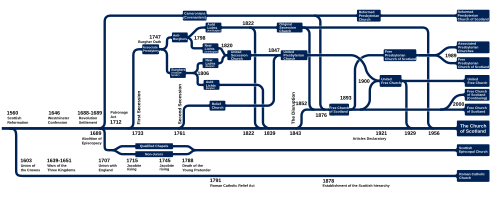Free Church of Scotland (1843–1900)
Despite the late founding date, Free Church of Scotland leadership claims an unbroken succession of leaders going back to the Apostles.[6] Leading up to the Disruption, many of the issues were discussed from an evangelical position in Hugh Miller's widely circulating newspaper The Witness.The evangelical element had been demanding the purification of the Church, and it attacked the patronage system, which allowed rich landowners to select the local ministers.Chalmers's idealised small equalitarian, kirk-based, self-contained communities that recognised the individuality of their members and the need for co-operation.Chalmers's ideals demonstrated that the church was concerned with the problems of urban society, and they represented a real attempt to overcome the social fragmentation that took place in industrial towns and cities.As she aspired to be the national church of the Scottish people, she set herself the ambitious task of establishing a presence in every parish in Scotland (except in the Highlands, where FC ministers were initially in short supply.)The church created a Sustentation Fund, the brainchild of Thomas Chalmers, to which congregations contributed according to their means, and from which all ministers received an 'equal dividend'.Some Free Churchmen like George Buchan, William Collins, John Wilson, and Henry Duncan themselves campaigned for the ultimate abolition of slavery.[17] When Frederick Douglass arrived in Scotland he became a vocal proponent of a "send back the money" campaign which urged the Free Church to return the £3,000 in donations.[18] In his autobiography, My Bondage and My Freedom, Douglass (p. 386) writes: The Free Church held on to the blood-stained money, and continued to justify itself in its position – and of course to apologize for slavery – and does so till this day.She lost a glorious opportunity for giving her voice, her vote, and her example to the cause of humanity; and to-day she is staggering under the curse of the enslaved, whose blood is in her skirts.Douglass spoke at three meetings in Dundee in 1846.In 1844, long before Douglass's arrival, Robert Smith Candlish had spoken against slavery in a debate about a man named John Brown.James Bannerman was appointed to the chair of Apologetics and Pastoral Theology and his The Church of Christ volumes 1[24] and 2[25] were widely read.[27] Attempts were made between 1890 and 1895 to bring many of these professors to the bar of the Assembly on charges of heresy, but these moves failed, with only minor warnings being issued.The importance of Home Missions also grew, these having the purpose of increasing church attendance, particularly amongst the poorer communities in large cities.The United Presbyterians held that, as the state had no authority in spiritual things, it was not within its jurisdiction to legislate as to what was true in religion, prescribe a creed or any form of worship for its subjects, or to endow the church from national resources.A joint committee made up of men from both denominations noted remarkable agreement on doctrinal standards, rules and methods.After a protracted legal battle, the House of Lords found in favour of the minority (in spite of the belief of most that the true kirk is above the state) and awarded them the right to keep the name Free Church of Scotland, though the majority was able to keep most of the financial resources.








ProtestantCalvinistPolityPresbyterianThomas ChalmersChurch of St. AndrewSeparated fromChurch of ScotlandFree Presbyterian Church of ScotlandScottishdenominationschismDisruption of 1843United Presbyterian Church of ScotlandUnited Free Church of ScotlandHouse of LordsBannatyne v. OvertounFree Church of Scotlandunbroken successionApostlesAlexander Colquhoun-Stirling-Murray-DunlopHill & AdamsonEvangelicalsencroachment on the spiritual independenceHugh MillerThe WitnessRobert CandlishAlexander Murray Dunlopprevious historical secessions of 1733or 1761patronage systemDr. WelshmansescollegeEducation Act of 1872Patrick MacFarlanChalmersGraham SpeirsLoch SunartStrontianEvangelicalUnited StatesabolitionistsGeorge BuchanWilliam CollinsJohn WilsonHenry DuncanFrederick DouglassRobert Smith CandlishB. B. WarfieldSouthern Presbyterian ChurchNew College, EdinburghNew CollegeChrist's CollegeTrinity CollegeWestminster CalvinismDavid WelshJames BuchananJames BannermanWilliam CunninghamJohn "Rabbi" DuncanA. B. BruceMarcus DodsGeorge Adam SmithliberalWilliam Robertson SmithUnited Presbyterian ChurchDeclaratory ActRobert Murray M'CheyneAndrew BonarmissionsJames StewartRobert Lawsevangelisation of the JewsWilliam Chalmers BurnsAlexander DuffJohn AndersonLake NyassaLebanonNew ZealandOtago AssociationThomas BurnsDunedinEdinburghWest Port1859 RevivalSankeyhymnologydisestablishmentReformed Presbyterian ChurchUnited PresbyteriansantidisestablishmentarianGeorge Harvey'sDr. GuthrieDr SmythDr ClasonDr HendersonDr GriersonDr N. PatersonDr BeithDr CunninghamDr BuchananDr Julius WoodThomas BrownHenry GreyJohn MacdonaldRobert James BrownJames SievewrightPatrick ClasonMackintosh MacKayNathaniel PatersonAngus MakellarJohn SmythJames GriersonJames HendersonThomas M'Crie the YoungerJames Julius WoodAlexander BeithRobert BuchananThomas GuthrieRoderick McLeodPatrick FairbairnJames BeggWilliam WilsonJohn RoxburghWilliam Nixon

